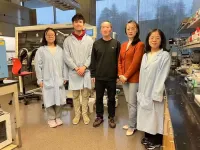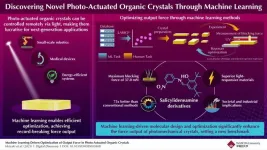(Press-News.org) PULLMAN, Wash. -- Researchers at Washington State University have demonstrated a way to use corn protein to improve the performance of lithium-sulfur batteries, a finding that holds promise for expanding the use of the high-energy, lighter-weight batteries in electric vehicles, renewable energy storage and other applications.
Lithium-sulfur batteries are lighter for the same amount of energy and more environmentally friendly than commonly used lithium-ion batteries, but their commercial adoption has been limited by technological hurdles that shorten their lifespan.
The WSU team’s research, published in the Journal of Power Sources, showed that a protective barrier made of corn protein, in combination with a commonly used plastic, significantly improved the performance of a button-sized lithium-sulfur battery. The researchers found that the battery could hold its charge over 500 cycles, a significant improvement over batteries without the protective corn barrier, known as a separator.
“This work demonstrated a simple and efficient approach to preparing a functional separator for enhancing the battery’s performance,” said Katie Zhong, professor in the School of Mechanical and Materials Engineering and a corresponding author on the paper. “The results are excellent.”
Lithium-sulfur batteries are considered a possible alternative to lithium-ion batteries for many applications. They theoretically contain a lot more energy, so using them in cars or airplanes would require much smaller and lighter batteries than current batteries. Furthermore, the lithium-sulfur battery uses sulfur for its cathode, which is abundantly available, cheap, and non-toxic, making it more environmentally friendly than current batteries. The cathode of a lithium-ion battery is made of metal oxides and include toxic heavy metals like cobalt or nickel.
However, lithium-sulfur batteries suffer from two major problems. Called the shuttle effect, the sulfur portion of the battery tends to leak into the liquid part of the battery and migrate to the lithium side, causing the battery to stop working very quickly. The lithium side of the battery also often grows spikes of lithium metal, called dendrites, which can cause an electric short circuit.
In their proof-of-concept work, the researchers used corn protein as a cover for a separator in the middle of the battery to prevent both problems.
“Corn protein would make for a good battery material because it’s abundant, natural, and sustainable,” said Jin Liu, professor in the School of Mechanical and Materials Engineering and a corresponding author on the paper.
Graduate students Ying Guo, Pedaballi Sireesha and Chenxu Wang led the work.
The building blocks of the protein are amino acids, which reacted with the battery materials to improve the movement of lithium ions and inhibit the shuttle effect. Because protein is naturally folded on top of itself, the researchers added a small amount of flexible plastic to flatten it and improve its performance.
“The first thing we need to think about is how to open the protein, so we can use those interactions and manipulate the protein,” said Liu.
The researchers conducted both numerical studies and experiments to prove the battery’s success. They are conducting further studies on how the process worked, which amino acid interactions might be responsible, and how the protein structure might be optimized.
“A protein is a very complicated structure,” said Zhong. “We need to do further simulation studies to identify which amino acids in the protein structure can work best for solving the critical shuttle effect and dendrite problems.”
The researchers would like to collaborate with industry partners to study larger experimental batteries and to scale up the process. The work was funded by the U.S. Department of Agriculture.
END
Corn leads to improved performance in lithium-sulfur batteries
2025-04-15
ELSE PRESS RELEASES FROM THIS DATE:
SynGAP Research Fund (SRF), dba Cure SYNGAP1, announces Board of Trustees Update 2025
2025-04-15
Mill Valley, CA – April 15, 2025 – SynGAP Research Fund (SRF), dba Cure SYNGAP1, the leading patient advocacy group dedicated to improving the lives of those affected by SYNGAP1-related disorders (SRD), today announced the appointment of Jaime Aranda, Steve Gore, Heather Mestemaker, and Brian Smith to its Board of Trustees, effective April 15, 2025. They will succeed outgoing Trustees Emily Barnes, Sydney Stelmaszek, and Stella Tavilla, whose terms conclude on April 14, 2025. Additionally, a seat previously held by Pavel Gerovich, who stepped ...
Machine learning unlocks superior performance in light-driven organic crystals
2025-04-15
Materials that convert external stimuli into mechanical motion, known as actuators, play a crucial role in robotics, medical devices, and other advanced applications. Among them, photomechanical crystals deform in response to light, making them promising for lightweight and remotely controllable actuation. Their performance depends on factors such as molecular structures, crystal properties, and experimental conditions.
A key performance indicator of these materials is the blocking force—the maximum force exerted when deformation is completely ...
Exploring the mutational landscape of colorectal cancer
2025-04-15
Colorectal cancer (CRC), a type of cancer that affects the large intestine and rectum, is one of the leading causes of cancer-related deaths worldwide. The mutational landscape of CRC is well characterized, revealing key pathogenic genetic abnormalities that drive carcinogenesis (cancer development) and disease progression. Moreover, a step-wise colorectal carcinogenesis model has been proposed wherein normal epithelial cells transition to adenoma (non-cancerous tumor) and then to carcinoma (cancerous tumor) as they sequentially acquire genetic mutations.
Mutations ...
Researchers have mapped the hidden control system of vision
2025-04-15
Vision is one of the most complex functions of our brain and requires a seamless interaction between many different brain structures to decode shapes, colours, depths, and movements and turn them into a meaningful whole. Just like other brain functions, vision also depends on a balanced and controlled interaction between the chemical signals that "activate" and "brake" activity in the eye's cells – much like the accelerator and brake of a car. In research, the "brake" is known as GABA, which stands for gamma-aminobutyric ...
Key to the high aggressiveness of pancreatic cancer identified
2025-04-15
Barcelona, 15th April 2025. – Pancreatic cancer is one of the most aggressive cancers and has one of the lowest survival rates—only 10% after five years. One of the factors contributing to its aggressiveness is its tumor microenvironment, known as the stroma, which makes up the majority of the tumor mass and consists of a network of proteins and different non-tumor cells. Among these, fibroblasts play a key role, helping tumor cells to grow and increasing their resistance to drugs. Now, a study led by researchers from the Hospital del Mar Research Institute, IIBB-CSIC-IDIBAPS, ...
How proactive salmon conservation in the North Pacific can deliver global benefits
2025-04-15
April 15, 2025 | Portland, Oregon—A new study in the journal Fisheries shows how a salmon-focused ecosystem protection strategy in the North Pacific can deliver meaningful results in the global drive to protect biodiversity.
The approach, called the stronghold strategy, aims to proactively protect the world’s greatest remaining “strongholds”—a select group of salmon, steelhead, and trout systems that collectively comprise 119 distinct watersheds. According to Wild Salmon Center President & CEO Guido Rahr—lead author of the peer-reviewed study—salmonids center the strategy because they are both iconic and globally recognized ...
Blocking chemokine receptor increases effectiveness of glucocorticoids in multiple myeloma treatment
2025-04-15
Researchers at the VIB-UGent Center for Medical Biotechnology have discovered a promising strategy to improve treatment responses in multiple myeloma patients by blocking a protein that plays a key role in drug resistance. The study, published in Pharmacological Research, offers a potential new strategy to improve outcomes for patients whose disease has become less responsive to standard therapies.
Multiple myeloma (MM) is a type of blood cancer that affects the bone marrow. Patients are often treated with dexamethasone, a synthetic glucocorticoid frequently used in the clinic to regulate immune responses and slow cancer growth. However, as the disease progresses, many patients develop ...
Amount of sunlight reaching Earth’s surface varies over decades, researchers report
2025-04-15
The sun may rise every morning, but the amount of sunlight reaching the Earth’s surface can substantially vary over decades, according to a perspectives article led by an international research team. The article, published on March 15 in Advances in Atmospheric Science, suggests that stages of “dimming” and “brightening” correspond with increased air pollution and implementation of clean energy solutions, respectively.
“The amount of sunlight — which is solar ...
Heart valve abnormality is associated with malignant arrhythmias
2025-04-15
People with a certain heart valve abnormality are at increased risk of severe heart rhythm disorders, even after successful valve surgery. This is according to a new study from Karolinska Institutet and Karolinska University Hospital in Sweden published in the European Heart Journal. The condition is more common in women and younger patients with valve disorder and can, in the worst case, lead to sudden cardiac arrest.
Mitral annular disjunction, MAD, is a heart abnormality in which the mitral valve attachment ‘slides’. In recent years, the condition has ...
Explainable AI for ship navigation raises trust, decreases human error
2025-04-15
The Titanic sunk 113 years ago on April 14-15, after hitting an iceberg, with human error likely causing the ship to stray into those dangerous waters. Today, autonomous systems built on artificial intelligence can help ships avoid such accidents, but could such a system explain to the captain why it was maneuvering a certain way?
That’s the idea behind explainable AI, which should help human actors trust autonomous systems more. Researchers from Osaka Metropolitan University’s Graduate School of Engineering have developed an explainable AI model for ships that quantifies the collision risk for all vessels ...





